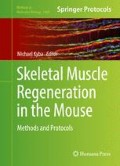Abstract
In response to muscle damage, satellite cells proliferate and undertake both differentiation and self-renewal, generating new functional muscle tissue and repopulating this new muscle with stem cells for future injury responses. For many questions relating to the physiological regulation of satellite cells, quantitative readouts of self-renewal and differentiation can be very useful. There is a particular need for a quantitative assay for satellite cell self-renewal that does not rely solely upon sectioning, staining and counting cells in sections. In this chapter, we provide detailed methods for quantifying the self-renewal and differentiation potential of a given population of satellite cells using an assay involving transplantation into injured, regenerating muscle together with specific markers for donor cell identity and state of differentiation. In particular, using the Pax7-ZsGreen transgene as a marker of satellite cell state, self-renewal can be quantified by FACS on transplanted muscle to actually count the total number of resident satellite cells at time points following transplantation.
Access this chapter
Tax calculation will be finalised at checkout
Purchases are for personal use only
References
Montarras D et al (2005) Direct isolation of satellite cells for skeletal muscle regeneration. Science 309(5743):2064–2067
Seale P et al (2000) Pax7 is required for the specification of myogenic satellite cells. Cell 102(6):777–786
Bosnakovski D et al (2008) Prospective isolation of skeletal muscle stem cells with a Pax7 reporter. Stem Cells 26(12):3194–3204
Hoffman EP, Brown RH Jr, Kunkel LM (1987) Dystrophin: the protein product of the Duchenne muscular dystrophy locus. Cell 51(6):919–928
Watkins SC, Hoffman EP, Slayter HS, Kunkel LM (1988) Immunoelectron microscopic localization of dystrophin in myofibres. Nature 333(6176):863–866
Petrof BJ, Shrager JB, Stedman HH, Kelly AM, Sweeney HL (1993) Dystrophin protects the sarcolemma from stresses developed during muscle contraction. Proc Natl Acad Sci U S A 90(8):3710–3714
Ervasti JM, Campbell KP (1991) Membrane organization of the dystrophin-glycoprotein complex. Cell 66(6):1121–1131
Sicinski P et al (1989) The molecular basis of muscular dystrophy in the mdx mouse: a point mutation. Science 244(4912):1578–1580
Arpke RW et al (2013) A new immuno- dystrophin-deficient model, the NSG-Mdx mouse, provides evidence for functional improvement following allogeneic satellite cell transplantation. Stem Cells 31:1611–1620
Bosma GC, Custer RP, Bosma MJ (1983) A severe combined immunodeficiency mutation in the mouse. Nature 301(5900):527–530
Cao X et al (1995) Defective lymphoid development in mice lacking expression of the common cytokine receptor gamma chain. Immunity 2(3):223–238
Chapman VM, Miller DR, Armstrong D, Caskey CT (1989) Recovery of induced mutations for X chromosome-linked muscular dystrophy in mice. Proc Natl Acad Sci U S A 86(4):1292–1296
Danko I, Chapman V, Wolff JA (1992) The frequency of revertants in mdx mouse genetic models for Duchenne muscular dystrophy. Pediatr Res 32(1):128–131
Hoffman EP, Morgan JE, Watkins SC, Partridge TA (1990) Somatic reversion/suppression of the mouse mdx phenotype in vivo. J Neurol Sci 99(1):9–25
Chan SS et al (2013) Mesp1 patterns mesoderm into cardiac, hematopoietic, or skeletal myogenic progenitors in a context-dependent manner. Cell Stem Cell 12(5):587–601
Blanco-Bose WE, Yao CC, Kramer RH, Blau HM (2001) Purification of mouse primary myoblasts based on alpha 7 integrin expression. Exp Cell Res 265(2):212–220
Fukada S et al (2007) Molecular signature of quiescent satellite cells in adult skeletal muscle. Stem Cells 25(10):2448–2459
Jesse TL, LaChance R, Iademarco MF, Dean DC (1998) Interferon regulatory factor-2 is a transcriptional activator in muscle where It regulates expression of vascular cell adhesion molecule-1. J Cell Biol 140(5):1265–1276
Seale P, Ishibashi J, Holterman C, Rudnicki MA (2004) Muscle satellite cell-specific genes identified by genetic profiling of MyoD-deficient myogenic cell. Dev Biol 275(2):287–300
Acknowledgments
This work was supported by grants from the NIH (R01 AR055685) and the Muscular Dystrophy Association (MDA351022).
Author information
Authors and Affiliations
Corresponding author
Editor information
Editors and Affiliations
Rights and permissions
Copyright information
© 2016 Springer Science+Business Media New York
About this protocol
Cite this protocol
Arpke, R.W., Kyba, M. (2016). Flow Cytometry and Transplantation-Based Quantitative Assays for Satellite Cell Self-Renewal and Differentiation. In: Kyba, M. (eds) Skeletal Muscle Regeneration in the Mouse. Methods in Molecular Biology, vol 1460. Springer, New York, NY. https://doi.org/10.1007/978-1-4939-3810-0_12
Download citation
DOI: https://doi.org/10.1007/978-1-4939-3810-0_12
Published:
Publisher Name: Springer, New York, NY
Print ISBN: 978-1-4939-3808-7
Online ISBN: 978-1-4939-3810-0
eBook Packages: Springer Protocols

